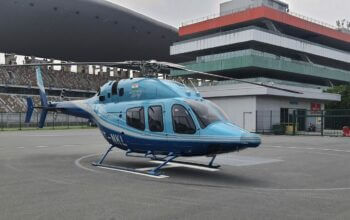Estimated reading time 5 minutes, seconds.
Bell is betting big on the technologies that will shape future vertical lift and flight, unveiling in the past 12 months the FCX-001 and the Hybrid Drive Train Research Aircraft to test new concepts for propulsion, rotor blades, airframe materials, energy harvesting, and artificial intelligence-assisted computer systems.

On Apr. 16, the federal government backed that bet with a $49.5 million investment in a Bell-led consortium of Canadian aerospace companies and academic researchers, focused on exploring innovative technologies for the next generation of helicopters.
The money comes from the Strategic Innovation Fund (SIF), part of the government’s Skills and Innovation Plan announced in the 2017 budget to help companies start up, scale up, and develop export opportunities.
Navdeep Bains, minister of Innovation, Science and Economic Development, made the announcement on the opening day of the Aerospace Innovation Forum, a biannual conference hosted by Aero Montreal and supported by the National Research Council of Canada (NRC).
The goal of the fund is to play a “key role in backing the next big idea,” he said.
The consortium’s research in alternate propulsion, autonomous systems and optionally piloted aircraft, situational awareness, advanced fly-by-wire systems, energy management, and advanced anti-torque could unlock new ideas in aircraft performance and safety.
“Suffice to say, that is an impressive amount of research and development and I applaud Bell and collaborators for their ambition and drive,” said Bains. “[The] investment will allow Bell to develop, manufacture and market specialized aircraft that will be more economical to run and kinder to our environment…This will have a significantly positive impact for the foreseeable future.”

The government said the investment would also generate and support about 300 quality jobs.
In an interview after, Bains told Skies the objective was less about breakthroughs in any one technology – “We’re really agnostic to the innovation” – and more about strengthening a leading national manufacturing sector.
“We want to see more collaboration between large, successful companies like Pratt & Whitney and Bell, with a lot of academic institutions and smaller companies. This is about promoting collaboration, strengthening the supply chain, and encouraging more research and development, which leads to more jobs.”
The consortium will consist of 19 partners, including engine manufacturer Pratt & Whitney Canada, Esterline CMC Electronics, Gastops, Marinvent, and various universities from Dalhousie in Halifax to the University of British Columbia in Vancouver, and many of the leading college and university aerospace programs in Quebec.
Fittingly, the announcement was made shortly after a wide-ranging panel discussion between Bell and Uber about the future of on-demand urban air transportation. Both companies are among many waging heavily on urban air taxis.

“Projects like this make ideas like that much more real and closer than we think,” said Cynthia Garneau, president of Bell Textron Canada, adding that SIF support was a major incentive to propose the project.
The consortium will focus on disruptive technologies “that are not yet committed to products” but can be brought to a level where risk is reduced and they are deemed airworthy. “We’ll not only develop the technologies, we’ll even go into prototyping and testing some of this in different ways. That’s why having academia and working with the NRC is going to helping us,” she told Skies.
Garneau noted that Bell’s Hybrid Drive Train Research Aircraft, or HYDRA, a circular unmanned aerial research platform, could provide the mechanism to trial some of the technology developed through the consortium.
“That’s what HYDRA allows us to do, to try stuff, further advance, and then try some more.”
“We’ve started flying HYDRA autonomously lately. It’s the first step before going for a full aircraft,” added Michel Dion, Bell’s manager of innovation, who will lead the consortium project.








